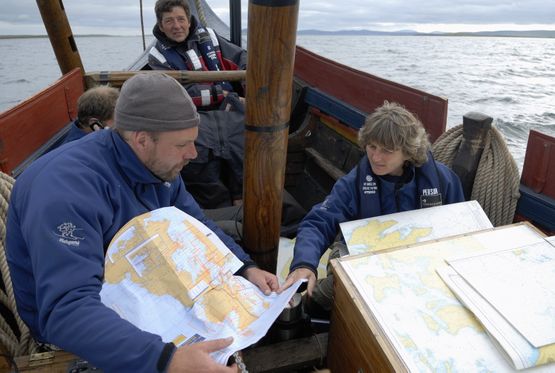
Skipper's law
The Gulating Law from Norway, which was written down during the 12th-13th century, contains several rules concerning the coxswain’s responsibilities and tasks on board the warship, as well as those of the ordinary crew.
On the larger warships the coxswain was often selected by the King, and was responsible for the ship both before, during and after the voyage. The coxswain selected the crew. If they did not report for duty or refused to sail they were issued with a fine. Prior to departure and on board different laws were in force concerning for example what each person should take with them and how they were organised on board.
According to the Gulating Law each member of the crew was paid a salary of 1 øre per month. What do you think this corresponds to? What was it possible to buy for 1 øre Do you think there were other opportunities for obtaining money on board such a ship – for example plundering on the way?
• If you were going to sail on board the Sea Stallion, but were only allowed to take along three things, what would you choose?
• The sleeping bag, Húdfat, was intended for two persons. Does it fit your picture of the Vikings that two men shared a sleeping bag? Why/why not?
• Write a code of practice for a warship on an expedition to Dublin in the Viking Age. Which rules should apply for the crew? What would you as the Skipper issue fines for?
• Make a code of practice for the Sea Stallion today. How strict must the rules be, and is it at all fair right to have a system of fines when the crew are all volunteers?
Skipper’s law
This exercise contains problems and suggestions for written work.
It deals with topics such as:
- Organisation of the ship
- Coxswain and Skipper
- Life on board
- Sources for the Viking Age
The following articles may help in solving the exercise:
- Holumenn
- Styrismaðr
- Crew
- Skipper
- The archaeological sources for the Viking Age
- Iconographic sources for the Viking Age
- Written sources for the Viking Age
Logs and diaries from the voyage to Dublin 2007/2008 and the Armchair comments may also provide inspiration.
The exercise can for example form part of a project about life on board, together with the exercises The duty roster, Sea fare, Stories aboard and Sailing.
This exercise could also be included in a project about the sources of information we have for the Viking Age. The archaeological, pictorial and written sources are all able to provide different information about the Vikings. They each have, however, their advantages and disadvantages; these could be discussed during lessons. The Gulating Law, which is mentioned in this exercise, was written down after the Viking Age. Which problems can this present and why?
Subjects: History, Science and Technology, English.
Suitable for age: 10-15 years.